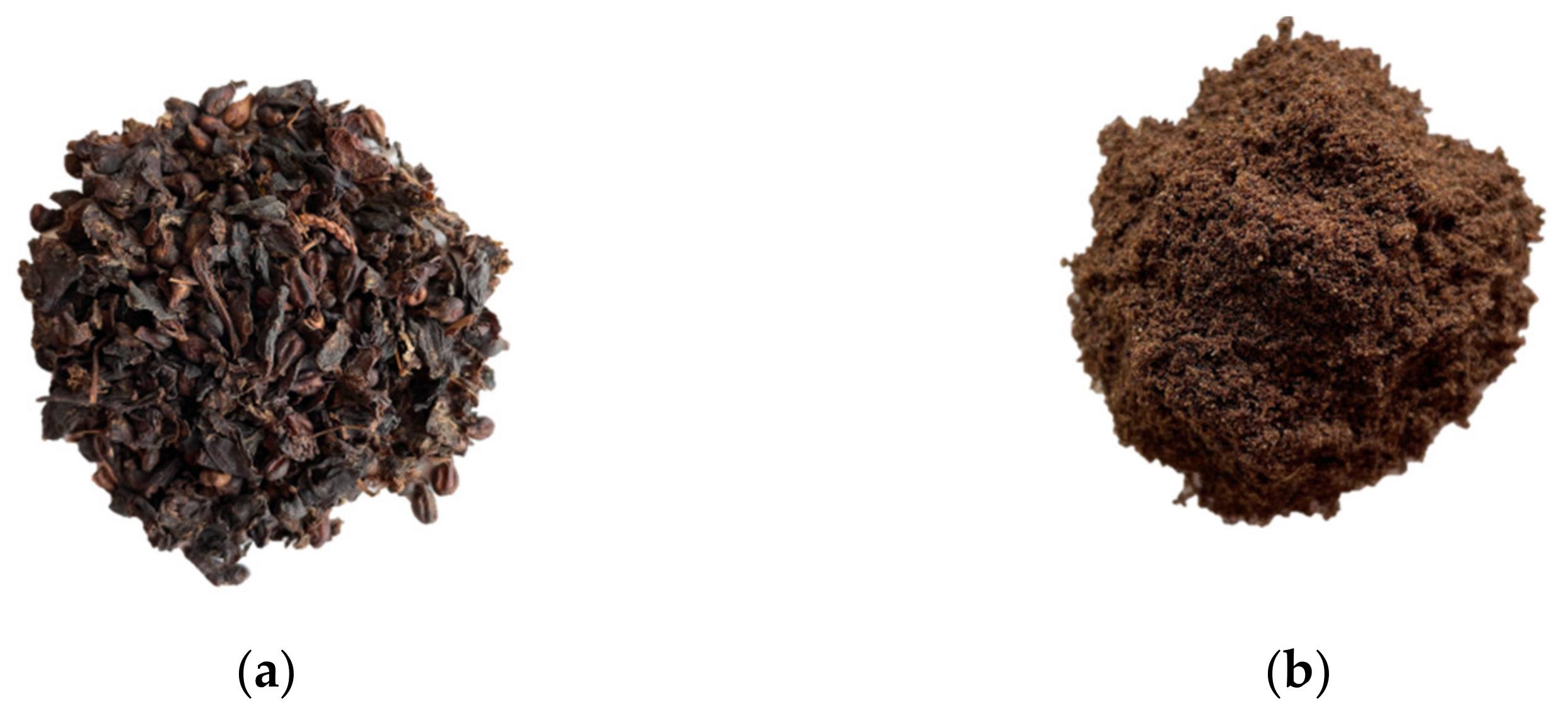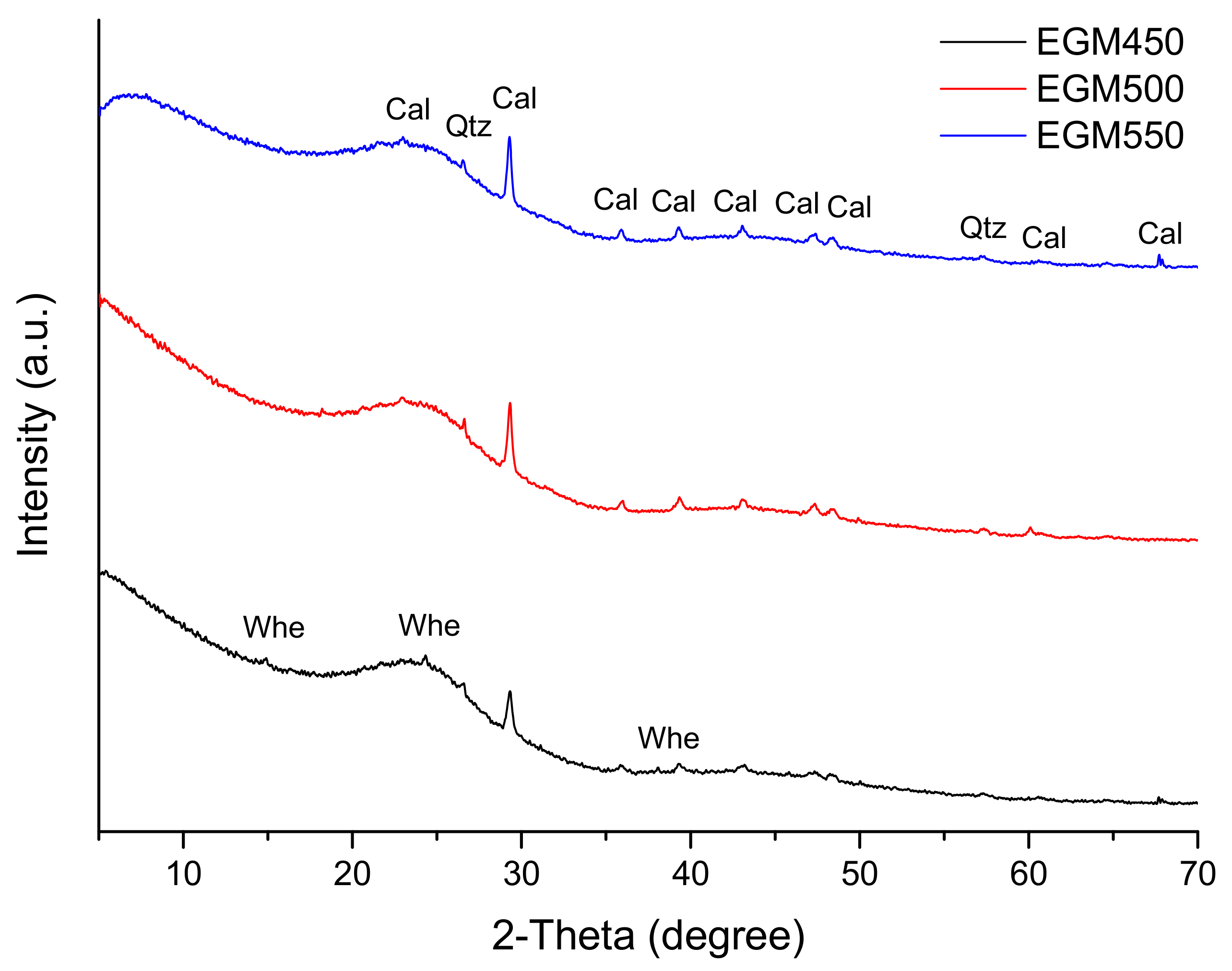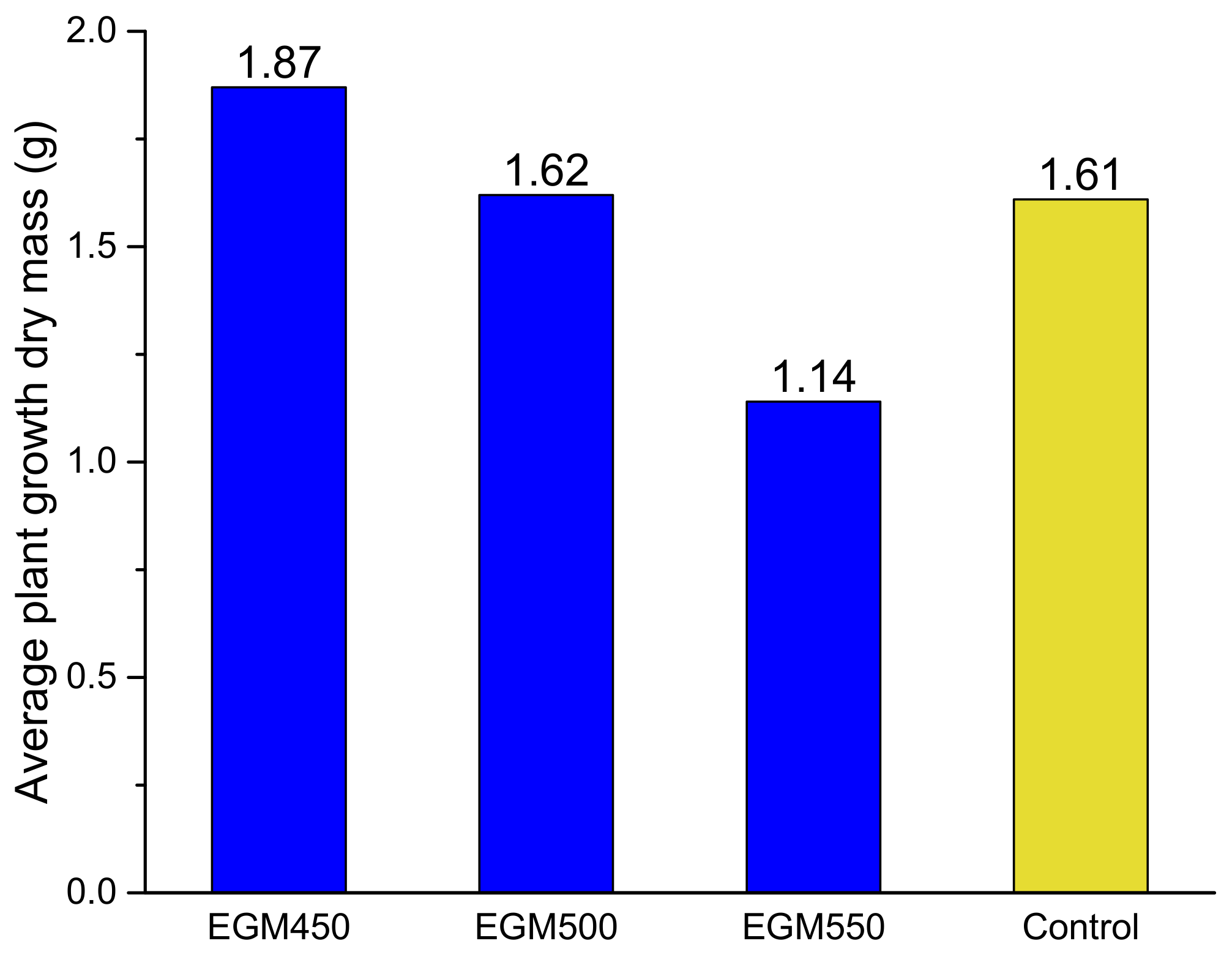Exhausted Grape Marc Derived Biochars: Effect of Pyrolysis Temperature on the Yield and Quality of Biochar for Soil Amendment
Abstract
:1. Introduction
2. Materials and Methods
2.1. Feedstock
2.2. Feedstock Analysis
2.3. Pyrolysis
2.3.1. TGA Study
2.3.2. Pyrolysis Experiments
2.4. Biochar Characterisation
2.5. Plant Growth Study
3. Results and Discussion
3.1. Thermo-Chemical Properties of EGM
| Parameter | Present Study | Literature 1 | Reference |
|---|---|---|---|
| Energy properties (MJ kg−1, dry basis) | |||
| HHV | 22.74 | 17.20–22.06 | [3,8,10,12,14,19] |
| LHV | 21.39 | 16.40–20.50 | [3,8,10,12,14,19] |
| CHONS analysis (wt. %, dry basis) | |||
| C | 49 | 43–54.90 | [3,8,10,12,14,21] |
| H | 6.39 | 5.56–9.28 | [3,8,10,12,14,21] |
| O | 37 | 30.40–45.50 | [3,8,10,12,14,21] |
| N | 2 | 0.65–2.59 | [3,8,10,12,14,21] |
| S | 0.12 | 0.11–1.24 | [3,8,10,12,14,21] |
| Mineral composition (mg kg−1, dry basis) | |||
| Al | 503 | 50 | [21] |
| Ca | 6409 | 6220 | [21] |
| Fe | 478 | 110 | [21] |
| Mg | 1326 | 890 | [21] |
| P | 3669 | 2570 | [21] |
| K | 8038 | 6770–37,900 | [8,21] |
| Si | 2631 | 330 | [21] |
| Na | 249 | 102–1809 | [8,21] |
| Cu | 53 | 6–279 | [8,21] |
| Organic composition (wt. %, dry basis) | |||
| Cellulose | 15.38 | 28.64 | [13] |
| Hemicellulose | 4.72 | – | – |
| Lignin | 42.46 | 41.98 | [13] |
| Devolatilization | |||
| T Start point 2 (°C) | 180 | – | – |
| T End point 3 (°C) | 483 | – | – |
| T max 4 (°C) | 323 | – | – |
| Rate max (wt. % min−1) | ~2 | – | – |
| Proximate analysis (wt. %, dry basis) | |||
| Total volatile matter | 71.9 | 63.60–72 | [3,8,10,12,14,19] |
| Fixed carbon | 22.4 | 20.68–28.20 | [3,8,10,12,14,19] |
| Ash | 5.7 | 3.46–8.20 | [3,8,10,12,14,19] |
3.2. Pyrolysis Characteristics of EGM
3.3. Properties of EGM-Based Biochars
3.4. Qualification of EGM-Based Biochar as a Potential Candidate for Soil Amendment
3.5. Plant Growth Study
4. Conclusions
Supplementary Materials
Author Contributions
Funding
Institutional Review Board Statement
Informed Consent Statement
Data Availability Statement
Acknowledgments
Conflicts of Interest
References
- Gómez-Brandón, M.; Lores, M.; Insam, H.; Domínguez, J. Strategies for Recycling and Valorization of Grape Marc. Crit. Rev. Biotechnol. 2019, 39, 437–450. [Google Scholar] [CrossRef]
- Nakai, J. Food and Agriculture Organization of the United Nations and the Sustainable Development Goals Natural Re-Sources Management Officer, FAO From the Millennium Development Goals to the Sustainable Development Goals. Sustain. Dev. 2018, 22, 3–11. [Google Scholar]
- Muhlack, R.A.; Potumarthi, R.; Jeffery, D.W. Sustainable Wineries through Waste Valorisation: A Review of Grape Marc Utilisation for Value-Added Products. Waste Manag. 2018, 72, 99–118. [Google Scholar] [CrossRef]
- Ahmad, B.; Yadav, V.; Yadav, A.; Rahman, M.U.; Yuan, W.Z.; Li, Z.; Wang, X. Integrated Biorefinery Approach to Valorize Winery Waste: A Review from Waste to Energy Perspectives. Sci. Total. Environ. 2020, 719, 137315. [Google Scholar] [CrossRef]
- Panorama Des Industries Agroalimentaires. Available online: https://agriculture.gouv.fr/Le-Panorama-Des-Industries-Agroalimentaires (accessed on 20 April 2021).
- State of the World Vitivinicultural Sector in 2020. Available online: https://www.oiv.int/public/medias/7909/oiv-State-of-the-World-Vitivinicultural-Sector-in-2020.Pdf (accessed on 20 April 2021).
- Ruiz-Moreno, M.J.; Raposo, R.; Cayuela, J.M.; Zafrilla, P.; Piñeiro, Z.; Rojas, J.M.M.; Mulero, J.; Puertas, B.; Girón, F.; Guerrero, R.F.; et al. Valorization of Grape Stems. Ind. Crop. Prod. 2015, 63, 152–157. [Google Scholar] [CrossRef]
- Toscano, G.; Riva, G.; Duca, D.; Pedretti, E.F.; Corinaldesi, F.; Rossini, G. Analysis of the Characteristics of the Residues of the Wine Production Chain Finalized to Their Industrial and Energy Recovery. Biomass-Bioenergy 2013, 55, 260–267. [Google Scholar] [CrossRef]
- Bordiga, M.; Travaglia, F.; Locatelli, M. Valorisation of Grape Pomace: An Approach That Is Increasingly Reaching Its Maturity—A Review. Int. J. Food Sci. Technol. 2019, 54, 933–942. [Google Scholar] [CrossRef]
- Zhang, N.; Hoadley, A.; Patel, J.; Lim, S.; Li, C. Sustainable Options for the Utilization of Solid Residues from Wine Production. Waste Manag. 2017, 60, 173–183. [Google Scholar] [CrossRef]
- Basu, P. Chapter 3—Pyrolysis and Torrefaction. In Biomass Gasification and Pyrolysis; Academic Press: Boston, FL, USA, 2010; pp. 65–96. ISBN 978-0-12-374988-8. [Google Scholar]
- Encinar, J.; Beltran, F.J.; Bernalte, A.; Ramiro, A.; González, J.F.G. Pyrolysis of Two Agricultural Residues: Olive and Grape Bagasse. Influence of Particle Size and Temperature. Biomass- Bioenergy 1996, 11, 397–409. [Google Scholar] [CrossRef]
- Demiral, I.; Ayan, E.A. Pyrolysis of Grape Bagasse: Effect of Pyrolysis Conditions on the Product Yields and Characterization of the Liquid Product. Bioresour. Technol. 2011, 102, 3946–3951. [Google Scholar] [CrossRef]
- Marculescu, C.; Ciuta, S. Wine Industry Waste Thermal Processing for Derived Fuel Properties Improvement. Renew. Energy 2013, 57, 645–652. [Google Scholar] [CrossRef]
- Spigno, G.; Marinoni, L.; Garrido, G.D. State of the Art in Grape Processing By-Products. In Handbook of Grape Processing By-Products; Elsevier BV: London, UK, 2017; pp. 1–27. [Google Scholar] [CrossRef]
- Basso, D.; Patuzzi, F.; Castello, D.; Baratieri, M.; Rada, E.C.; Weiss-Hortala, E.; Fiori, L. Agro-Industrial Waste to Solid Biofuel through Hydrothermal Carbonization. Waste Manag. 2016, 47, 114–121. [Google Scholar] [CrossRef] [PubMed] [Green Version]
- Xu, R.; Ferrante, L.; Briens, C.; Berruti, F. Flash Pyrolysis of Grape Residues into Biofuel in a Bubbling Fluid Bed. J. Anal. Appl. Pyrolysis 2009, 86, 58–65. [Google Scholar] [CrossRef]
- Valente, M.; Brillard, A.; Schönnenbeck, C.; Brilhac, J.-F. Investigation of Grape Marc Combustion Using Thermogravimetric Analysis. Kinetic Modeling Using an Extended Independent Parallel Reaction (EIPR). Fuel Process. Technol. 2015, 131, 297–303. [Google Scholar] [CrossRef]
- Casazza, A.A.; Aliakbarian, B.; Lagazzo, A.; Garbarino, G.; Carnasciali, M.M.; Perego, P.; Busca, G. Pyrolysis of Grape Marc before and After the Recovery of Polyphenol Fraction. Fuel Process. Technol. 2016, 153, 121–128. [Google Scholar] [CrossRef]
- Tounsi, M.S.; Ouerghemmi, I.; Wannes, W.A.; Ksouri, R.; Zemni, H.; Marzouk, B.; Kchouk, M.E. Valorization of Three Varieties of Grape. Ind. Crop. Prod. 2009, 30, 292–296. [Google Scholar] [CrossRef]
- Ibn Ferjani, A.; Jeguirim, M.; Jellali, S.; Limousy, L.; Courson, C.; Akrout, H.; Thevenin, N.; Ruidavets, L.; Muller, A.; Bennici, S. The Use of Exhausted Grape Marc to Produce Biofuels and Biofertilizers: Effect of Pyrolysis Temperatures on Biochars Properties. Renew. Sustain. Energy Rev. 2019, 107, 425–433. [Google Scholar] [CrossRef]
- Torres-Garcia, E.; Brachi, P. Non-Isothermal Pyrolysis of Grape Marc. J. Therm. Anal. Calorim. 2019, 139, 1463–1478. [Google Scholar] [CrossRef]
- Zacharof, M.-P. Grape Winery Waste as Feedstock for Bioconversions: Applying the Biorefinery Concept. Waste Biomass Valorization 2016, 8, 1011–1025. [Google Scholar] [CrossRef] [Green Version]
- Rivera, O.M.P.; Leos, M.D.S.; Solis, V.E.; Domínguez, J.M. Recent Trends on the Valorization of Winemaking Industry Wastes. Curr. Opin. Green Sustain. Chem. 2021, 27, 100415. [Google Scholar] [CrossRef]
- Balat, M.; Balat, M.; Kırtay, E.; Balat, H. Main Routes for the Thermo-Conversion of Biomass into Fuels and Chemicals. Part 1: Pyrolysis Systems. Energy Convers. Manag. 2009, 50, 3147–3157. [Google Scholar] [CrossRef]
- Fahmy, T.Y.A.; Fahmy, Y.; Mobarak, F.; El-Sakhawy, M.; Abou-Zeid, R.E. Biomass Pyrolysis: Past, Present, and Future. Environ. Dev. Sustain. 2018, 22, 17–32. [Google Scholar] [CrossRef]
- Xie, T.; Reddy, K.; Wang, C.; Yargicoglu, E.; Spokas, K. Characteristics and Applications of Biochar for Environmental Remediation: A Review. Crit. Rev. Environ. Sci. Technol. 2015, 45, 939–969. [Google Scholar] [CrossRef]
- Schmidth, H.P.; Bucheli, T.; Kammann, C.; Glaser, B.; Abiven, S. EBC (2012) “EuropeanEuropean Biochar Certificate—Guidelines for a Sustainable Production of Biochar”; EBC: Arbaz, Switzerland, 2021. [Google Scholar]
- Ding, Y.; Liu, Y.; Liu, S.; Li, Z.; Tan, X.; Huang, X.; Zeng, G.; Zhou, L.; Zheng, B. Biochar to Improve Soil Fertility. A Review. Agron. Sustain. Dev. 2016, 36, 36. [Google Scholar] [CrossRef] [Green Version]
- Verheijen, F.; Jeffery, S.; Bastos, A.C.; Van Der Velde, M.; Diafas, I. Biochar Application to Soils—A Critical Scientific Review of Effects on Soil Properties, Processes and Functions. EUR 24099 EN; European Commission: Luxembourg, 2010; Volume 8, ISBN 9789279142932. [Google Scholar]
- Kookana, R.S.; Sarmah, A.K.; Van Zwieten, L.; Krull, E.; Singh, B. Biochar Application to Soil. Agronomic and Environmental Benefits and Unintended Consequences. In Advances in Agronomy; Elsevier Inc.: Amsterdam, The Netherlands, 2011; Volume 112, pp. 103–143. ISBN 9780123855381. [Google Scholar]
- Kavitha, B.; Reddy, P.V.L.; Kim, B.; Lee, S.S.; Pandey, S.K.; Kim, K.-H. Benefits and Limitations of Biochar Amendment in Agricultural Soils: A Review. J. Environ. Manag. 2018, 227, 146–154. [Google Scholar] [CrossRef]
- Guo, X.-X.; Liu, H.-T.; Zhang, J. The Role of Biochar in Organic Waste Composting and Soil Improvement: A Review. Waste Manag. 2020, 102, 884–899. [Google Scholar] [CrossRef]
- Van Soest, P.J. Use of Detergents in the Analysis of Fibrous Feeds. II. A Rapid Method for the Determination of Fiber and Lignin. J.-Assoc. Off. Anal. Chem. 1990, 73, 491–497. [Google Scholar] [CrossRef]
- Groenli, M.G. A Theoretical and Experimental Study of the Thermal Degradation of Biomass. Master’s Thesis, Norges teknisknaturvitenskapelige Universitet, Trondheim, Norway, 1996. [Google Scholar]
- Lombaert, V. Micro-cultures, Stanford-De Ment Methods [determination of the short term availability of fertilizers, diagnosis of soil fertility]. Dossiers Agronomiques d’Aspach-le-Bas 1987, 2, 59–86. [Google Scholar]
- Werner, K.; Pommer, L.; Broström, M. Thermal Decomposition of Hemicelluloses. J. Anal. Appl. Pyrolysis 2014, 110, 130–137. [Google Scholar] [CrossRef]
- Mohan, D.; Pittman, C.U.; Steele, P.H. Pyrolysis of Wood/Biomass for Bio-Oil: A Critical Review. Energy Fuels 2006, 20, 848–889. [Google Scholar] [CrossRef]
- Örsi, F. Kinetic Studies on the Thermal Decomposition of Glucose and Fructose. J. Therm. Anal. Calorim. 1973, 5, 329–335. [Google Scholar] [CrossRef]
- Grammelis, P.; Margaritis, N.; Kourkoumpas, D.-S. 4.27 Pyrolysis Energy Conversion Systems. Compr. Energy Syst. 2018, 1065–1106. [Google Scholar] [CrossRef]
- Rajapaksha, A.U.; Mohan, D.; Igalavithana, A.D.; Lee, S.S.; Ok, Y.S. Definitions and Fundamentals of Biochar. In Biochar: Production, Characterization, and Applications; Ok, Y.S., Uchimiya, S.M., Chang, S.X., Bolan, N., Eds.; Urbanization, Industrialization, and the Environment; CRC Press: Boca Raton, FL, USA, 2016; pp. 4–16. ISBN 978-1-4822-4230-0. [Google Scholar]
- Wang, S.; Dai, G.; Yang, H.; Luo, Z. Lignocellulosic Biomass Pyrolysis Mechanism: A State-of-the-Art Review. Prog. Energy Combust. Sci. 2017, 62, 33–86. [Google Scholar] [CrossRef]
- Gholizadeh, M.; Hu, X.; Liu, Q. A Mini Review of the Specialties of the Bio-Oils Produced from Pyrolysis of 20 Different Bio-Masses. Renew. Sustain. Energy Rev. 2019, 114, 109313. [Google Scholar] [CrossRef]
- Singh, B.; Camps-Arbestain, M.; Lehmann, J. Biochar: A Guide to Analytical Methods; Csiro Publishing: Clayton Southy, Australia, 2017; ISBN 9781486305094. [Google Scholar]
- Frost, R.L.; Weier, M.L. Thermal Treatment of whewellite—A Thermal Analysis and Raman Spectroscopic Study. Thermochim. Acta 2004, 409, 79–85. [Google Scholar] [CrossRef] [Green Version]
- Bruckman, V.J.; Varol, E.A.; Uzun, B.B.; Liu, J. Biochar: A Regional Supply Chain Approach in View of Climate Change Mitigation; Cambridge University Press: Cambridge, UK, 2016; ISBN 9780333227794. [Google Scholar]
- Chan, K.Y.; Xu, Z. Biochar: Nutrient Properties and Their Enhancement. In Biochar for Environmental Management; Routledge: Oxfordshire, UK, 2012; pp. 99–116. [Google Scholar]
- Ibn Ferjani, A.; Jellali, S.; Akrout, H.; Limousy, L.; Hamdi, H.; Thevenin, N.; Jeguirim, M. Nutrient Retention and Release from Raw Exhausted Grape Marc Biochars and an Amended Agricultural Soil: Static and Dynamic Investigation. Environ. Technol. Innov. 2020, 19, 100885. [Google Scholar] [CrossRef]









| Modality | Experiment | K2O Amendment (kg ha−1) |
|---|---|---|
| M1 | Ryegrass seed (1.8) + Soil (1.2 kg) + Minerals | 50 U K2O |
| M2 | Ryegrass seed (1.8) + Soil (1.2 kg) + Biochar | 50 U K2O |
| Temperature | 350 °C | 400 °C | 450 °C | 475 °C | 500 °C | 525 °C | 550 °C | 575 °C | 600 °C |
| Char Yield | 50.6 | 41.9 | 37.3 | 35.9 | 35.2 | 34.5 | 33.9 | 33.2 | 32.6 |
| Volatiles Yield | 49.4 | 58.1 | 62.7 | 64.0 | 64.9 | 65.6 | 66.0 | 66.8 | 67.4 |
| Temperature | 450 °C | 500 °C | 550 °C |
| Char yield | 41.1 | 39.5 | 37.7 |
| Liquid yield | 18.7 | 24.4 | 20.2 |
| Gas yield | 40.2 | 36.1 | 42.1 |
| EGM450 | EGM500 | EGM550 | |
|---|---|---|---|
| CHONS analysis (wt. %, dry basis) | |||
| Total C | 77.50 | 80.00 | 79.90 |
| H | 3.32 | 2.90 | 2.50 |
| O | 7.29 | 5.36 | 4.76 |
| N | 2.57 | 2.42 | 2.54 |
| S | <0.30 | <0.30 | <0.30 |
| O/C molar ratio 1 | 0.07 | 0.05 | 0.04 |
| H/C molar ratio 1 | 0.51 | 0.44 | 0.38 |
| C/N molar ratio 1 | 35.17 | 38.55 | 36.69 |
| Mineral composition (mg kg−1, dry basis) | |||
| As | <0.80 | <0.80 | <0.80 |
| Cr | 2 | 5 | 12 |
| Al | 423 | 237 | 709 |
| Ca | 13,900 | 13,600 | 16,500 |
| Fe | 480 | 426 | 712 |
| K | 24,500 | 24,900 | 28,200 |
| Mg | 2590 | 2430 | 2950 |
| Na | 366 | 354 | 461 |
| P | 6460 | 6710 | 7560 |
| Si | 2060 | 3070 | 5060 |
| Proximate analysis (wt. %, dry basis) | |||
| Total volatile matter | 23.06 | 19.10 | 17.20 |
| Fixed carbon | 67.92 | 71.88 | 72.80 |
| Ash | 9.02 | 9.02 | 10 |
| Specific surface area (m2 g−1) | 170 | 193 | 219 |
| Micropore volume (cm3 g−1) | 0.091 | 0.098 | 0.116 |
| Mean pore size (nm) | 0.56 | 0.56 | 0.61 |
| pH | 10.8 | 10.4 | 10.4 |
Publisher’s Note: MDPI stays neutral with regard to jurisdictional claims in published maps and institutional affiliations. |
© 2021 by the authors. Licensee MDPI, Basel, Switzerland. This article is an open access article distributed under the terms and conditions of the Creative Commons Attribution (CC BY) license (https://creativecommons.org/licenses/by/4.0/).
Share and Cite
Frikha, K.; Limousy, L.; Arif, M.B.; Thevenin, N.; Ruidavets, L.; Zbair, M.; Bennici, S. Exhausted Grape Marc Derived Biochars: Effect of Pyrolysis Temperature on the Yield and Quality of Biochar for Soil Amendment. Sustainability 2021, 13, 11187. https://doi.org/10.3390/su132011187
Frikha K, Limousy L, Arif MB, Thevenin N, Ruidavets L, Zbair M, Bennici S. Exhausted Grape Marc Derived Biochars: Effect of Pyrolysis Temperature on the Yield and Quality of Biochar for Soil Amendment. Sustainability. 2021; 13(20):11187. https://doi.org/10.3390/su132011187
Chicago/Turabian StyleFrikha, Kawthar, Lionel Limousy, Muhammad Bilal Arif, Nicolas Thevenin, Lionel Ruidavets, Mohamed Zbair, and Simona Bennici. 2021. "Exhausted Grape Marc Derived Biochars: Effect of Pyrolysis Temperature on the Yield and Quality of Biochar for Soil Amendment" Sustainability 13, no. 20: 11187. https://doi.org/10.3390/su132011187








